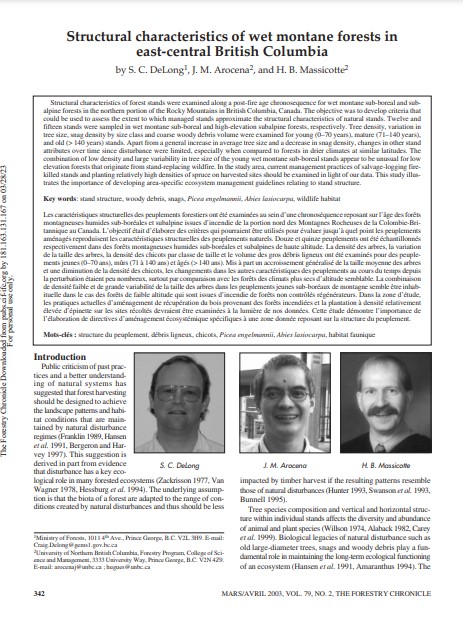Structural characteristics of wet montane forests in east-central British Columbia
Bosque Modelo:
McGregor
Temática:
Conservación
Tipo de documento:
Artículo científico
Resumen
Structural characteristics of forest stands were examined along a post-fire age chronosequence for wet montane sub-boreal and subalpine forests in the northern portion of the Rocky Mountains in British Columbia, Canada. The objective was to develop criteria that could be used to assess the extent to which managed stands approximate the structural characteristics of natural stands. Twelve and fifteen stands were sampled in wet montane sub-boreal and high-elevation subalpine forests, respectively. Tree density, variation in tree size, snag density by size class and coarse woody debris volume were examined for young (0–70 years), mature (71–140 years), and old (> 140 years) stands. Apart from a general increase in average tree size and a decrease in snag density, changes in other stand attributes over time since disturbance were limited, especially when compared to forests in drier climates at similar latitudes. The combination of low density and large variability in tree size of the young wet montane sub-boreal stands appear to be unusual for low elevation forests that originate from stand-replacing wildfire. In the study area, current management practices of salvage-logging firekilled stands and planting relatively high densities of spruce on harvested sites should be examined in light of our data. This study illustrates the importance of developing area-specific ecosystem management guidelines relating to stand structure.
Información Bibliográfica
Autor:
DeLong, SC, JM Arocena and HB Massicotte.
Revista:
Forestry Chronicle
Año:
2003
N°:
2
País :
Canadá
Páginas:
342 - 351
Volumen:
79
Idioma:
Ingles
Palabras claves
stand structure, woody debris, snags, Picea engelmannii, Abies lasiocarpa, wildlife habitat





